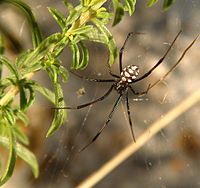- Latrodectus tredecimguttatus
-
Latrodectus tredecimguttatus 
Female L. tredecimguttatus Scientific classification Kingdom: Animalia Phylum: Arthropoda Class: Arachnida Order: Araneae Suborder: Araneomorphae Family: Theridiidae Genus: Latrodectus Species: L. tredecimguttatus Binomial name Latrodectus tredecimguttatus
Rossi, 1790Latrodectus tredecimguttatus, commonly known as the Mediterranean black widow or steppe spider, is a species of widow spiders in the genus Latrodectus. It is commonly found throughout the Mediterranean region, ranging from Spain to southwest and central Asia, hence the name. Specimens from central Asia are also known by the binomial name Latrodectus lugubris; that name, however, is considered obsolete, though it is still commonly found in the literature. Many consider this spider a Latrodectus mactans subspecies.
Contents
Etymology
L. tredecimguttatus bears different names in different regions. For example, in Southern France it is called l'araignée malmignatte. Throughout the Central Asia and Eastern Slavic region (part of Balkans), the name qaraqurt is most often applied. A direct translation from Altaic languages qara is "black", while qurt mean "insect" or "bug".
Appearance
L. tredecimguttatus is black in color, similar to most other widow species, and is identified by the thirteen spots which are found on its dorsal abdomen (the species name is Latin for "with thirteen spots"). These spots are usually red in colour, but may also be yellow or orange. It is otherwise similar to other species in the genus Latrodectus. The Mediterranean widow primarily lives in steppes and other grasslands, and can be a significant problem in areas where grain is harvested by hand. The female of the species has a leg span of about 10-20mm, while the male is smaller and reaches 4-7mm at best. Only the female spider's bite is dangerous (either for humans or cattle) as the male cannot penetrate the relatively thick epidermis.
Toxicity
Like all Latrodectus species, L. tredecimguttatus has a painful bite that is fatal in rare cases. There are many reports of Ukrainian farm workers receiving bites while working in the fields.
In Kazakhstan, there are reports of this species biting and killing camels.[1]It is believed that this species is the cause of tarantism, often falsely attributed to the wolf spider (Lycosa tarantula).
Interesting facts
- Today the karakurt is considered to be the same species of spider as that which plagued the farmers of Taranto, whose deeds have long time been attributed to Lycosa tarantula;
- Even in Ancient Greece this spider was well known for its dangerous bite[citation needed];
References
External links
Categories:- Latrodectus
- Venomous spiders
- Spiders of Europe
Wikimedia Foundation. 2010.

